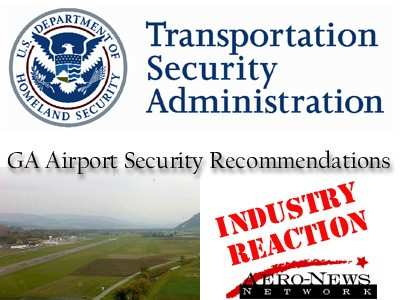Thu, May 20, 2004
Says It's "Pleased" At TSA Guidelines
 The TSA, after months of
preparation, released its General Aviation Security Recommendations
to the public earlier this week. Sent out as a TSA Information
Publication (IP), the guidelines are suggested security procedures
for general aviation airports and are not meant to be considered
mandatory.
The TSA, after months of
preparation, released its General Aviation Security Recommendations
to the public earlier this week. Sent out as a TSA Information
Publication (IP), the guidelines are suggested security procedures
for general aviation airports and are not meant to be considered
mandatory.
The guidelines are a result of months of work by the Aviation
Security Advisory Committee (ASAC) General Aviation Working Group
and the TSA. The ASAC developed a list of recommendations based on
best practices of the general aviation community. The TSA
incorporated each of those recommendations into the final guidance
document, with greater overall detail provided to eliminate
ambiguity.
"Overall, NATA is pleased with the guidance document and is
appreciative of the fact that the TSA took our recommendations into
consideration while drafting the IP," stated NATA president James
K. Coyne. "The document will be a great asset for those looking to
improve upon their already sufficient security plans."

The framework of the IP is seven functional areas –
personnel, aircraft, airports/facilities, surveillance, security
plans and communications and specialty operations. The IP also
provides a method for airports to determine their security needs,
realizing that there is no "one size fits all" approach when it
comes to airport security.
The TSA considers the IP a "living document" that will be
updated and modified as new security enhancements are developed and
as they receive additional input from the aviation industry.
One of the concerns raised with the issuing of this IP is how
the states will react. Early indications from some states are that
these recommendations could be codified into state law.
"Our only concern with the IP is that states may interpret this
document as regulatory framework and make the recommendations
mandatory," Coyne continued. "That is not the use for which the TSA
or the ASAC intended the document and the TSA and industry must
ensure that the states recognize this."
More News
During The Forced Landing, The Airplane’s Float Struts And Spreaderbars Collapsed Analysis: While en route to a remote fishing lodge in a float-equipped airplane, one of the >[...]
"X-59 is a symbol of American ingenuity. The American spirit knows no bounds. It's part of our DNA – the desire to go farther, faster, and even quieter than anyone has ever g>[...]
Aero Linx: The Honourable Company of Air Pilots The advancement of the public interest by the promotion of safety for all those who are employed in connection with or who travel by>[...]
Minimum Friction Level The friction level specified in AC 150/5320-12, Measurement, Construction, and Maintenance of Skid Resistant Airport Pavement Surfaces, that represents the m>[...]
Aero Linx: Aerospace Industries Association (AIA) For over 100 years, the American aerospace and defense industry has shaped the world around us. From the first flight to the moon >[...]
 NTSB Final Report: Dehavilland DHC-2 MK 1
NTSB Final Report: Dehavilland DHC-2 MK 1 Aero-News: Quote of the Day (10.29.25)
Aero-News: Quote of the Day (10.29.25) ANN's Daily Aero-Linx (10.29.25)
ANN's Daily Aero-Linx (10.29.25) ANN's Daily Aero-Term (10.30.25): Minimum Friction Level
ANN's Daily Aero-Term (10.30.25): Minimum Friction Level ANN's Daily Aero-Linx (10.30.25)
ANN's Daily Aero-Linx (10.30.25)




